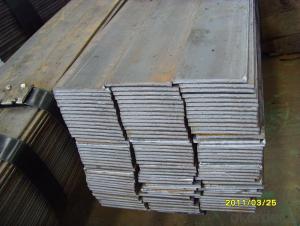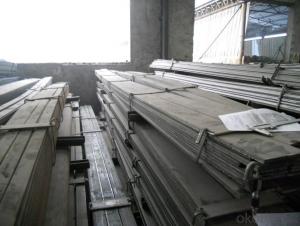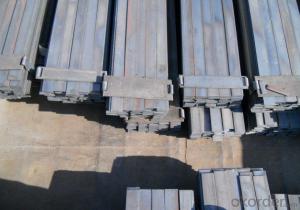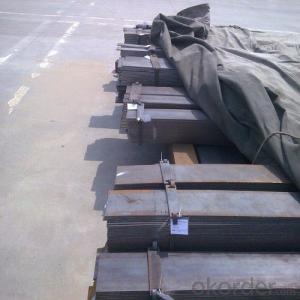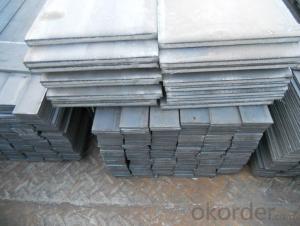Wide Flat Bar High Quality Q235 Hot Rolled 3MM-30MM
- Loading Port:
- Shanghai
- Payment Terms:
- TT or LC
- Min Order Qty:
- 25 m.t.
- Supply Capability:
- 10000 m.t./month
OKorder Service Pledge
OKorder Financial Service
You Might Also Like
Product Applications:
Wide Flat Bar High Quality Q235 Hot Rolled 3MM-30MM are ideal for structural applications and are widely used in the construction of buildings and bridges, and the manufacturing, petrochemical, and transportation industries.
Product Advantages:
OKorder's Wide Flat Bar High Quality Q235 Hot Rolled 3MM-30MM are durable, strong, and resist corrosion.
Main Product Features:
· Premium quality
· Prompt delivery & seaworthy packing (30 days after receiving deposit)
· Corrosion resistance
· Can be recycled and reused
· Mill test certification
· Professional Service
· Competitive pricing
Product Specifications:
Manufacture: Hot rolled
Grade: Q195 – 235
Certificates: ISO, SGS, BV, CIQ
Length: 6m – 12m, as per customer request
Packaging: Export packing, nude packing, bundled
Chinese Standard (H*W*T) | Weight (Kg/m) | 6m (pcs/ton) | Light I (H*W*T) | Weight (Kg/m) | 6m (pcs/ton) | Light II (H*W*T) | Weight (Kg/m) | 6M |
100*68*4.5 | 11.261 | 14.8 | 100*66*4.3 | 10.13 | 16.4 | 100*64*4 | 8.45 | 19.7 |
120*74*5.0 | 13.987 | 11.9 | 120*72*4.8 | 12.59 | 13.2 | 120*70*4.5 | 10.49 | 15.8 |
140*80*5.5 | 16.89 | 9.8 | 140*78*5.3 | 15.2 | 10.9 | 140*76*5 | 12.67 | 13.1 |
160*88*6 | 20.513 | 8.1 | 160*86*5.8 | 18.46 | 9 | 160*84*5.5 | 15.38 | 10.8 |
180*94*6.5 | 24.143 | 6.9 | 180*92*6.3 | 21.73 | 7.6 | 180*90*6 | 18.11 | 9.2 |
200*100*7 | 27.929 | 5.9 | 200*98*6.8 | 25.14 | 6.6 | 200*96*6.5 | 20.95 | 7.9 |
220*110*7.5 | 33.07 | 5 | 220*108*7.3 | 29.76 | 5.6 | 220*106*7 | 24.8 | 6.7 |
250*116*8 | 38.105 | 4.3 | 250*114*7.8 | 34.29 | 4.8 | 250*112*7.5 | 28.58 | 5.8 |
280*122*8.5 | 43.492 | 3.8 | 280*120*8.2 | 39.14 | 4.2 | 280*120*8 | 36.97 | 4.5 |
300*126*9 | 48.084 | 3.4 | 300*124*9.2 | 43.28 | 3.8 | 300*124*8.5 | 40.87 | 4 |
320*130*9.5 | 52.717 | 3.1 | 320*127*9.2 | 48.5 | 3.4 | |||
360*136*10 | 60.037 | 2.7 | 360*132*9.5 | 55.23 | 3 |
FAQ:
Q1: How do we guarantee the quality of our products?
A1: We have established an advanced quality management system which conducts strict quality tests at every step, from raw materials to the final product. At the same time, we provide extensive follow-up service assurances as required.
Q2: How soon can we receive the product after purchase?
A2: Within three days of placing an order, we will begin production. The specific shipping date is dependent upon international and government factors, but is typically 7 to 10 workdays.
Q3: What makes stainless steel stainless?
A3: Stainless steel must contain at least 10.5 % chromium. It is this element that reacts with the oxygen in the air to form a complex chrome-oxide surface layer that is invisible but strong enough to prevent further oxygen from "staining" (rusting) the surface. Higher levels of chromium and the addition of other alloying elements such as nickel and molybdenum enhance this surface layer and improve the corrosion resistance of the stainless material.

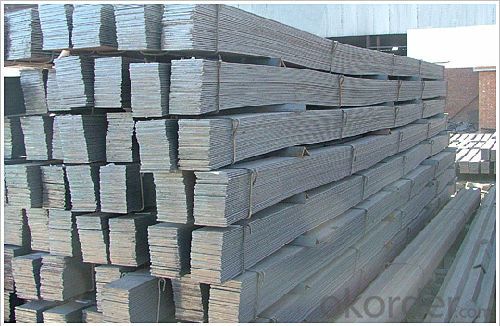
- Q:How do you paint or coat steel flat bars?
- To paint or coat steel flat bars, you will need to follow a few steps. First, you need to prepare the surface of the steel. This involves removing any rust, dirt, or old paint using sandpaper, a wire brush, or a power tool such as a grinder. It is important to ensure that the surface is clean and smooth before proceeding. Next, you should apply a primer to the steel bars. The primer helps to create a bond between the steel and the paint or coating, improving adhesion and durability. Choose a primer specifically designed for metal surfaces and apply it evenly using a brush, roller, or spray gun. Make sure to follow the manufacturer's instructions regarding drying time and recommended number of coats. After the primer has dried, you can proceed to apply the paint or coating. Again, choose a paint or coating specifically made for metal surfaces. You can use a brush, roller, or spray gun to apply the paint, depending on your preference and the size of the flat bars. Apply multiple thin coats, allowing each coat to dry completely before applying the next. This helps to achieve a smooth and even finish. If you are using a coating instead of paint, make sure to follow the manufacturer's instructions regarding application and drying time. Some coatings may require curing at a specific temperature or may need a topcoat for added protection. After the paint or coating has dried completely, inspect the surface for any imperfections or areas that might need touch-ups. If necessary, lightly sand any rough spots and apply additional coats of paint or coating as needed. Remember to work in a well-ventilated area and wear appropriate safety gear, such as gloves and a mask, when painting or coating steel flat bars. Following these steps will help you achieve a professional and long-lasting finish on your steel flat bars.
- Q:Are steel flat bars suitable for welding fixtures?
- Yes, steel flat bars are suitable for welding fixtures. They provide a strong and stable base for holding and aligning materials during the welding process. Additionally, steel's high durability and resistance to heat make it an ideal choice for welding fixtures as it can withstand the stresses and temperatures involved in welding.
- Q:What is the difference between carbon steel and tool steel flat bars?
- The main difference between carbon steel and tool steel flat bars lies in their composition and purpose. Carbon steel flat bars are primarily made of iron and carbon, with relatively low levels of other alloying elements. They are generally used in applications where strength and durability are essential, but precise cutting or shaping capabilities are not required. On the other hand, tool steel flat bars are specifically designed for their use in toolmaking, with higher levels of alloying elements such as chromium, vanadium, or tungsten. These alloying elements enhance their hardness, resistance to wear, and ability to hold a sharp cutting edge, making them ideal for applications that involve cutting, drilling, or shaping materials.
- Q:Can steel flat bars be used for structural support?
- Yes, steel flat bars can be used for structural support. They are commonly used in construction projects to provide stability and support in various applications such as beams, columns, braces, and frames. The high strength and durability of steel make it an ideal material for structural support, ensuring the safety and stability of the structure.
- Q:What are the common methods of cutting steel flat bars?
- There are various techniques commonly employed for the cutting of steel flat bars. 1. Manual cutting entails the utilization of hand tools like hacksaws or bolt cutters to slice through the steel. Although it is a slower and more labor-intensive process, it is suitable for small-scale projects or situations where access to power tools is limited. 2. Abrasive cutting involves the use of abrasive wheels or discs to grind through the steel. This method is typically executed with a handheld angle grinder or a stationary abrasive saw. While abrasive cutting is relatively rapid and efficient, it may yield a rougher edge that necessitates further finishing. 3. Band saw cutting is frequently employed, utilizing band saws equipped with metal-cutting blades. This technique enables more precise and accurate cuts, especially for larger or thicker bars. Band saws are available in various sizes, including portable options for on-site cutting or larger industrial models for heavy-duty cutting. 4. Plasma cutting employs a high-velocity jet of ionized gas, known as plasma, to melt through the steel. This method is renowned for its speed and versatility, allowing for the cutting of different thicknesses of steel and the production of clean and precise cuts. Plasma cutting machines are commonly utilized in industrial settings. 5. Laser cutting involves the use of a high-powered laser beam to melt and vaporize the steel, resulting in a precise and smooth cut. This technique is highly accurate and capable of producing intricate designs or patterns. However, laser cutting machines can be costly and are typically utilized in specialized fabrication shops or manufacturing facilities. When selecting the appropriate method for cutting steel flat bars, it is essential to consider factors such as desired cut quality, accuracy, speed, and available resources.
- Q:What are the different certifications and standards for steel flat bars?
- There are various certifications and standards for steel flat bars, including ASTM (American Society for Testing and Materials) standards such as A36, A572, and A36/A572-50, which specify the chemical composition and mechanical properties of the steel. Additionally, there are international standards such as EN 10025, which is the European standard for structural steel. Other certifications and standards may include ISO 9001 for quality management systems, ISO 14001 for environmental management systems, and OHSAS 18001 for occupational health and safety management systems.
- Q:What are the common tolerances for steel flat bars?
- The common tolerances for steel flat bars can vary depending on the specific requirements and standards set by the industry or customer. However, there are generally accepted tolerances that are widely used in the manufacturing and construction sectors. In terms of thickness, the common tolerance for steel flat bars is typically ± 0.005 inches or ± 0.13 millimeters. This means that the actual thickness of the flat bar can deviate by up to 0.005 inches or 0.13 millimeters from the specified thickness. For width, the common tolerance is usually ± 0.020 inches or ± 0.5 millimeters. This means that the actual width of the flat bar can vary by up to 0.020 inches or 0.5 millimeters from the specified width. In terms of length, the common tolerance is typically ± 0.125 inches or ± 3 millimeters. This means that the actual length of the flat bar can deviate by up to 0.125 inches or 3 millimeters from the specified length. It is important to note that these common tolerances may vary depending on the specific application, industry standards, or customer requirements. Therefore, it is always advisable to consult the relevant standards or specifications to determine the precise tolerances for a particular steel flat bar.
- Q:How do you prevent twisting of steel flat bars during welding?
- To prevent twisting of steel flat bars during welding, it is essential to properly clamp and secure the bars in place. This can be achieved by using strong and sturdy clamps or fixtures, ensuring that the bars are held tightly and aligned correctly. Additionally, evenly distributing the heat during welding and using proper welding techniques can help minimize the chances of twisting.
- Q:How do you protect steel flat bars from weathering?
- There are various ways to safeguard steel flat bars from weathering. Applying a protective coating is a popular and effective method. This can be accomplished using paint, varnish, or a specialized metal coating that forms a barrier between the steel and the elements. The coating acts as a shield, preventing moisture from reaching the steel's surface and causing rust or corrosion. Prior to applying any coating, it is vital to ensure that the steel flat bars are devoid of dirt, grease, or existing rust. Thoroughly clean the surface using a degreaser and a wire brush or sandpaper to eliminate any loose rust or paint. Once the surface is clean and dry, the coating can be applied. Another approach to shield steel flat bars from weathering is through galvanization. This process involves coating the steel with a layer of zinc, which offers excellent corrosion resistance. Galvanization can be achieved through hot-dip galvanization, where the steel is submerged in a bath of molten zinc, or through electroplating, where a layer of zinc is applied using an electric current. Galvanized steel flat bars are highly resistant to moisture and atmospheric corrosion, making them ideal for outdoor applications. Aside from coatings and galvanization, proper storage and maintenance are also crucial for protecting steel flat bars from weathering. Storing them in a dry environment, away from direct exposure to rain or snow, can significantly extend their lifespan. Regular inspections and cleaning can help promptly identify and address any signs of rust or corrosion, preventing further damage. If any signs of weathering are detected, it is important to remove the affected area and reapply a protective coating to prevent further deterioration. By utilizing these methods and implementing appropriate preventative measures, steel flat bars can be effectively safeguarded from weathering, ensuring their longevity and durability.
- Q:How do steel flat bars contribute to the overall stability of a structure?
- The overall stability of a structure is significantly improved with the use of steel flat bars. These bars possess exceptional tensile strength, allowing them to withstand immense forces without bending or breaking. As a result, they provide crucial structural support, preventing the structure from collapsing under heavy loads or external pressures. Furthermore, steel flat bars are commonly employed as braces or reinforcements in construction. They can be strategically positioned and welded to different sections of the structure to enhance its rigidity and prevent any potential deformations. Through the even distribution of weight, these bars play a key role in maintaining the structural integrity and preventing undesirable movements or vibrations. Additionally, steel flat bars exhibit remarkable durability and resistance to corrosion, making them ideal for long-term use in various environments. This durability ensures that the structure remains stable and secure over time, even when exposed to harsh conditions, moisture, or chemicals. Moreover, the versatility of steel flat bars allows for their application in a wide range of structural scenarios. Whether they are used for beams, columns, trusses, or as a foundation for other components, these bars provide stability and support to different parts of the structure. They can be easily customized and fabricated to meet specific design requirements, guaranteeing that the structure is constructed to withstand the intended loads and forces. In conclusion, steel flat bars are essential elements in enhancing the overall stability of a structure. Their exceptional tensile strength, resistance to deformation, durability, and versatility make them indispensable components in construction projects. By offering support, reinforcement, and resistance against external forces, these bars contribute significantly to the structural integrity and safety of the built environment as a whole.
1. Manufacturer Overview |
|
|---|---|
| Location | |
| Year Established | |
| Annual Output Value | |
| Main Markets | |
| Company Certifications | |
2. Manufacturer Certificates |
|
|---|---|
| a) Certification Name | |
| Range | |
| Reference | |
| Validity Period | |
3. Manufacturer Capability |
|
|---|---|
| a)Trade Capacity | |
| Nearest Port | |
| Export Percentage | |
| No.of Employees in Trade Department | |
| Language Spoken: | |
| b)Factory Information | |
| Factory Size: | |
| No. of Production Lines | |
| Contract Manufacturing | |
| Product Price Range | |
Send your message to us
Wide Flat Bar High Quality Q235 Hot Rolled 3MM-30MM
- Loading Port:
- Shanghai
- Payment Terms:
- TT or LC
- Min Order Qty:
- 25 m.t.
- Supply Capability:
- 10000 m.t./month
OKorder Service Pledge
OKorder Financial Service
Similar products
New products
Hot products
Hot Searches
Related keywords
